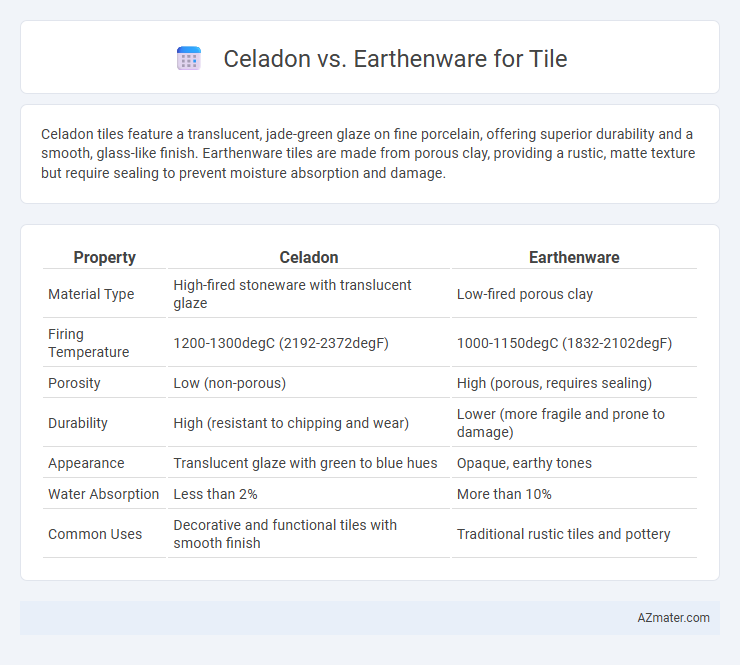Celadon tiles feature a translucent, jade-green glaze on fine porcelain, offering superior durability and a smooth, glass-like finish. Earthenware tiles are made from porous clay, providing a rustic, matte texture but require sealing to prevent moisture absorption and damage.
Table of Comparison
| Property | Celadon | Earthenware |
|---|---|---|
| Material Type | High-fired stoneware with translucent glaze | Low-fired porous clay |
| Firing Temperature | 1200-1300degC (2192-2372degF) | 1000-1150degC (1832-2102degF) |
| Porosity | Low (non-porous) | High (porous, requires sealing) |
| Durability | High (resistant to chipping and wear) | Lower (more fragile and prone to damage) |
| Appearance | Translucent glaze with green to blue hues | Opaque, earthy tones |
| Water Absorption | Less than 2% | More than 10% |
| Common Uses | Decorative and functional tiles with smooth finish | Traditional rustic tiles and pottery |
Introduction to Celadon and Earthenware Tiles
Celadon tiles feature a translucent glaze that creates a smooth, glass-like surface with subtle greenish or bluish hues, ideal for adding elegance to interior spaces. Earthenware tiles are made from porous clay fired at lower temperatures, resulting in a more rustic appearance with warm, earthy tones suited for casual or traditional decor. Both tile types vary in durability and water absorption, with celadon offering a harder finish and earthenware providing more texture and character.
Historical Origins and Cultural Significance
Celadon tiles originated in ancient China during the Tang Dynasty, famed for their jade-like green glaze achieved through iron oxide firing techniques, symbolizing elegance and status in East Asian architecture. Earthenware tiles date back to Neolithic times, utilized across various cultures for their porous clay base and fired at lower temperatures, reflecting everyday utility and accessibility in historical construction. Both materials reveal distinct cultural values: celadon embodies refined artistry and imperial prestige, while earthenware represents practical craftsmanship integral to domestic and communal spaces.
Material Composition and Manufacturing Processes
Celadon tiles are typically made from high-quality porcelain or stoneware clay, characterized by a dense, vitrified body achieved through high-temperature firing, which results in enhanced durability and water resistance. Earthenware tiles, composed of red or white clay with higher iron content, undergo lower firing temperatures, producing a porous, less dense material that requires a glaze to prevent moisture absorption. The manufacturing processes of celadon involve precise control of kiln atmosphere to develop their signature translucent glaze with subtle green hues, whereas earthenware relies on a simpler firing method that yields a more rustic, matte finish.
Visual Aesthetics: Color, Texture, and Glaze
Celadon tiles exhibit a translucent, jade-like glaze that enhances their smooth, glassy texture and subtle green to blue hues, creating a refined and elegant visual appeal. Earthenware tiles, characterized by their porous, matte surface and warm, earthy tones ranging from terracotta to ochre, provide a rustic and natural aesthetic. The glaze on earthenware is typically thicker and less glossy than celadon, emphasizing texture and artisanal craftsmanship over sleekness.
Durability and Strength Comparison
Celadon tiles, glazed with a translucent finish, exhibit higher durability and resistance to wear compared to traditional earthenware tiles, which are more porous and prone to chipping. The vitrification process in celadon increases its density and strength, making it suitable for heavy-traffic areas, whereas earthenware remains softer and less resistant to impact. For applications requiring robust performance and longevity, celadon provides superior structural integrity over earthenware tile options.
Water Absorption and Porosity Differences
Celadon tiles exhibit lower water absorption rates, typically below 5%, due to their dense, vitrified structure, making them more resistant to moisture penetration compared to earthenware tiles. Earthenware tiles have higher porosity levels, often absorbing over 10% water, which increases their susceptibility to damage from freeze-thaw cycles and staining. The reduced porosity in celadon results from its high-temperature firing process, which produces a glassy surface, while earthenware is fired at lower temperatures, retaining a more porous, less durable matrix.
Applications in Modern Interior Design
Celadon tiles offer a smooth, translucent glaze with a calming green-blue hue, ideal for creating elegant backsplashes and sophisticated bathroom walls in modern interiors. Earthenware tiles, known for their porous texture and warm, earthy tones, excel in rustic kitchens, cozy living spaces, and accent flooring that emphasizes a handcrafted aesthetic. Both materials provide versatile options, with celadon enhancing sleek, minimalist designs and earthenware contributing to organic, inviting environments.
Maintenance and Longevity Considerations
Celadon tiles feature a durable, glazed surface that resists stains and requires minimal maintenance, making them ideal for high-traffic areas. Earthenware tiles, being more porous and less vitrified, demand regular sealing and careful cleaning to prevent moisture damage and staining. Over time, celadon tiles typically offer greater longevity due to their enhanced hardness and reduced susceptibility to wear compared to earthenware.
Cost Factors and Accessibility
Celadon tiles, known for their translucent glaze and intricate craftsmanship, typically incur higher costs due to the precision required in their production and limited availability in the market. Earthenware tiles offer a more budget-friendly option, produced using abundant clay materials and simpler firing techniques, making them widely accessible and versatile for various projects. The cost disparity largely stems from Celadon's labor-intensive glazing process and rarity, whereas Earthenware benefits from mass production and broader distribution channels.
Choosing the Right Tile: Celadon or Earthenware?
Celadon tiles, known for their translucent glaze and subtle green-blue hues, offer a durable, water-resistant surface ideal for bathrooms and kitchens, while earthenware tiles provide a more porous, rustic texture suited for low-moisture areas like living rooms or patios. Choosing between celadon and earthenware depends on the functional requirements and aesthetic preferences of the space, with celadon excelling in humidity-prone environments and earthenware enhancing natural, earthy designs. Consider factors like maintenance, durability, and style coherence to select the right tile for your project.

Infographic: Celadon vs Earthenware for Tile
 azmater.com
azmater.com